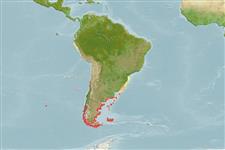Common names from other countries
Classification / Names / Names
Nomi Comuni | Sinonimi | Catalog of Fishes (gen., sp.) | ITIS | CoL | WoRMS
Environment: milieu / climate zone / depth range / distribution range
Ecologia
; distribuzione batimetrica 0 - 15 m (Ref. 83435). Temperate
Southwest Atlantic and Southeast Pacific: Uruguay to Falkland Islands and Strait of Magellan to Beagle Channel.
Length at first maturity / Size / Peso / Age
Maturity: Lm ? range ? - ? cm Max length : 2.2 cm SHL maschio/sesso non determinato; (Ref. 83435)
Found on rocky bottoms in channels and open and exposed coasts (Ref. 87801).
Life cycle and mating behavior
Maturità | Riproduzione | Deposizione | Uova | Fecundity | Larve
Members of the order Patellogastropoda are mostly gonochoric and broadcast spawners. Life cycle: Embryos develop into planktonic trocophore larvae and later into juvenile veligers before becoming fully grown adults.
Häussermann, V. and G. Försterra. 2009. (Ref. 87801)
IUCN Red List Status (Ref. 130435)
CITES status (Ref. 108899)
Not Evaluated
Not Evaluated
Threat to humans
Harmless
Human uses
| FishSource |
Strumenti
Informazioni ulteriori
Age/Size
Accrescimento
Length-weight
Length-length
Morfologia
Larve
Abbondanza
Fonti Internet
Estimates based on models
Preferred temperature
(Ref.
115969): 9.2 - 16, mean 12.5 (based on 196 cells).
